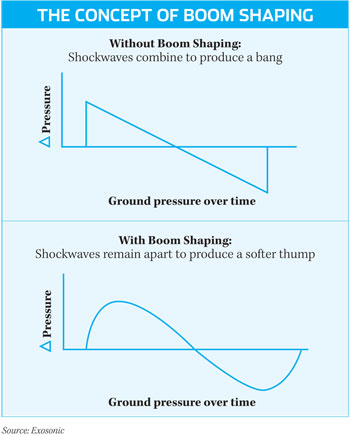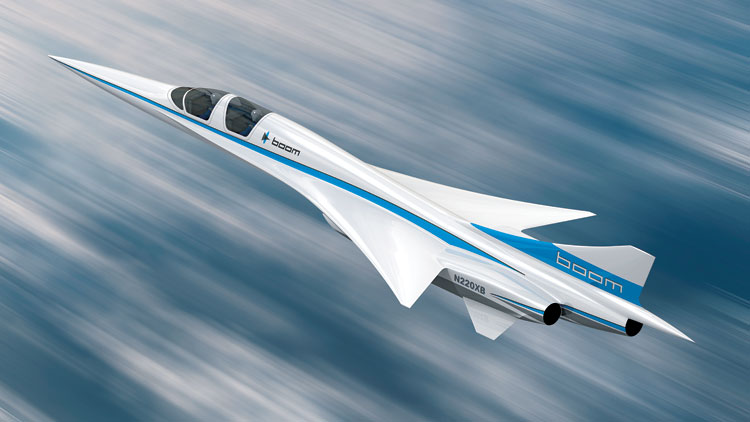Are we at the Cusp of Supersonic Airliners?
Air transport is witnessing a wave of innovations and one such development is the foray into supersonic flight

As airliners have evolved, the advancements in aircraft can be traced to three basic factors, namely, size, efficiency and speed. As for size, from 1980s onwards, the size of aircraft has remained stable from the point of view of average seat count by aircraft type. On the aspect of efficiency, aircraft have progressively delivered better performance that has largely been driven by engine manufacturers. From 1980 onwards, the efficiency gains have been to the tune of 70 per cent. But on speed, aircraft have not evolved significantly despite the fact that technology has been readily available. This is likely to change in the near future.
Air transport is witnessing a wave of innovations and one such development is the foray into supersonic flight. With the technology available today, a transcontinental trip should take only three to four hours but instead it takes seven to eight hours. Progress on attaining higher cruising speeds has been stagnant since the grounding of the Concorde in 2003. Airlines are flying slower segments and longer flights, and the airport experience is only getting worse. And as demand shifts eastward, there is a distinct segment that will readily pay for flights at higher speeds. This is the opportunity that supersonic airliners may target.
TYPES OF AIRCRAFT AND THEIR AVERAGE SPEED
| Aircraft | Year | Speed (mph) |
|---|---|---|
| Wright Flyer | 1903 | 68 |
| DC3 | 1935 | 207 |
| Lockheed Connie | 1951 | 330 |
| Boeing 707 | 1957 | 625 |
| Boeing 747 | 1969 | 583 |
| Concorde | 1969 | 1354 |
| Airbus 330 | 1992 | 541 |
| Boeing 777 | 1994 | 587 |
MODELS OF SUPERSONIC AIRCRAFT
| Company | Aircraft Type | Speed (Mach No.) | Passenger Capacity* |
|---|---|---|---|
| Aerion | Business jet | 1.2 | 8–12 |
| Boom | Passenger jet | 2.2 | 55–75 |
| Hypermach | Business jet | 6.6 | 50–55 |
| Exosonic | Passenger jet | 1.8 | 50–70 |
| Spike Aerospace | Business jet | 1.8 | N/A |

Traditional arguments against supersonic airliners have included challenges in respect of policy, planning and profitability. But it seems these are gradually thawing. On the policy front, in 2018, the Federal Aviation Administration, the aviation regulator of the United States (US), was re-authorised by the US Congress and was tasked to formulate regulations in respect of supersonic civil transport. Furthermore, the ban on supersonic flight over the US that has been in effect since 1973 is to be reviewed by 2025. To be sure, this ban only extends on flights over land and does not apply to flights over the sea. And in the event this is lifted which is likely to be the case, it will open up to ten times the routes that are currently available. Planning challenges are also gradually alleviated as airlines have worked with new structures and subsidiaries whereby the core operation is not disrupted. Because failing that, airlines will end up cannibalising their own routes both in terms of revenue and costs. Finally, in respect of profitability, the market size for supersonic aircraft is estimated to be between $200 and $300 billion. The marketsize speaks volumes because in the grand scheme of things, it is a small market. Thus traditional manufacturers such as Airbus and Boeing are not likely to focus on this area excluding projects funded by the military. The field is thus open for newcomers and by extension, for disruptive innovation.
To be sure, aircraft designers have already been designing aircraft that fly just below the speed of sound. The Gulfstream G650 flies at Mach 0.925 while the Cessna Citation X flies at Mach 0.935. Pushing this just a bit more, brings it into the realm of supersonic transport. Here innovations in wing design are already underway and engine makers, having delivered very high efficiency from existing engines, are likely to be up for a new challenge. Indeed, as it stands, several engine makers will move to clean sheet designs for the next round of development in the domain of power plants.
On the technology front, new composite materials, advances in propulsion and innovations in sound modeling, are paving the way. Extensive work has been done on “boom-shaping” which refers to how the shockwaves are separated once the sound barrier is broken. Aerospace designers have worked with structures that leverage design towards boom shaping thereby minimising impact.

Airlines are flying slower segments and longer flights, and the airport experience is only getting worse. And as demand shifts eastward, there is a distinct segment that will readily pay for flights at higher speeds
Furthermore, several factors are aligning which may have flight-path ahead clearing up for supersonic transport. This includes movements such as flight-shaming in Europe, the move to “green-equity” or the fact that the world requires transport solutions that are just faster and better. With airliners that fly twice as fast, on a consolidated basis, the “waste” generated is half as much. Utilisation doubles and perhaps “all-premium” operators will emerge. In the race are firms that range from Aerion Supersonic, Boom Technology, HyperMach, Exosonic and Spike Aerospace. And to make this possible, the funding sources include venture capital ecosystem, foreign governments, organisations such as NASA and also the US Air Force. The US government actually has a technology accelerator programme for start-ups.
That said, supersonic airliners will always be a niche segment as almost all operators are of the view that this can only be used as a premium service. Yet, as urbanisation trends rise and global wealth increases, financial centres will most certainly be a target market. This will also pose a challenge for mega-hubs and the full-service airlines as the hypothesis is that the premium traveler will pay for time saved rather than for comfort. As such, the most profitable portion of demand will move away from regular carriers to supersonic airliners. And this is a challenge that aircraft manufacturers will have to address.
It may well be the case, as was with the Concorde, that the seats on supersonic airliners may actually not be completely reclining business class. But then, on a three and a half-hour flight that gets you from London to New York or potentially a four-hour flight from New Delhi to London, maximising the space a passenger has to manoeuver is just one aspect of the planning proposition. Once they return to the skies, the supersonic airliners will indeed be a game changer.
The famed venture capitalist Peter Thiel astutely observed that we are so busy looking at our phones that we have failed to see that there has been very little innovation in transport, and how we move goods and people around us. Indeed, while ordering cabs via the phone or communicating via short characters or via messages that disappear has been innovative, transportation solutions for the most part have stayed the same. With supersonic transport once again on the anvil, that may just change in the years to come.





